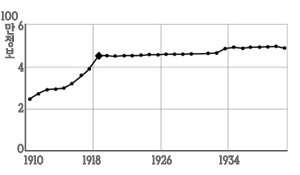Soybeans harvested with a combine in Walnut, Illinois. U.S. farmers increased the harvesting of soybeans at the fastest pace in at least three decades as warm, dry weather allowed for fieldwork after a drought this year reduced yields.
Food prices that doubled in the past 10 years are more the result of population growth and increased demand for protein-based diets than any cyclical reasons, according to Sunny Verghese, chief executive officer at Olam International Ltd. (OLAM), the Singapore-based commodities trader.
Three of the biggest annual gains in food prices in the past 20 years occurred since 2007, with the United Nations Food & Agriculture Organization’s global food price index climbing to a record in 2010. Wheat and soybeans led commodities gains last year and corn jumped to a record in August.
“We’ve had a long period of food real price declines and food surpluses and we’ve had three very rapid food crises,” Verghese said at the Kingsman sugar conference in Dubai yesterday. “The price inflation that we’ve seen in the three episodes is more a structural story and not a cyclical issue.”
The United Nations’ Food & Agiculture Organization has said global food output must rise 70 percent by 2050 to feed a world population expected to grow to 9 billion from 7 billion now and as increasingly wealthy consumers in developing economies eat more meat. Agriculture has “good demand growth,” Chris Mahoney, director of agricultural products at Baar, Switzerland- based trader Glencore International Plc (GLEN), said at the conference yesterday.
“In just seven years, the world will need not only to produce, but to move 20 percent more food and also store it, transport it and process it,” Mahoney said. “Without the transport, logistics infrastructure and processing capacity, production even if it keeps pace with demand will be unable to reach the consumer.”
Global Demand
Global oilseed demand is growing at about 3 percent a year, while corn consumption is rising a “little less,” according to Mahoney. Wheat, rice and sugar demand worldwide are expanding at or just below 2 percent a year, he said.
“What concerns people, and perhaps it should, is that the demand side of the equation is clear and it’s predictable, but this demand growth will largely need to be met by yield gain, not by additional planted area and the true potential for yield gain is perhaps known by only a few,” Mahoney said.
High food costs contributed to civil unrest across the Middle East and North Africa in 2011, toppling governments in Tunisia and Egypt. The U.S. State Department estimates that surging food prices triggered more than 60 riots worldwide from 2007 to 2009. In India, about 60 percent of what people spend is on food, compared with 70 percent to 80 percent in Africa, 45 percent inChina, 9 percent in Europe and about 10 percent in the U.S., according to Olam’s Verghese.
‘Serious Problem’
“When you have 50-percent price inflation in the core commodities and 70 percent of your consumption basket is spent on food, then you have a serious problem,” Verghese said.
High food prices are needed to send farmers a signal to increase plantings, Verghese said. Countries from India and Egypt to Vietnam and Indonesia banned exports of rice, a staple for half the world, during the 2008 food crisis. Russia in 2010 banned cereal exports after the country’s worst drought in at least half a century destroyed crops and cut production.
“Price controls are precisely the wrong thing to do when you want to induce a supply response,” Verghese said. “You are distorting the price signal to the farmer to try to increase its production.”
Producing ethanol and biodiesel from food crops is “questionable,” Mahoney said. As many as 150 million tons of grains globally are used to produce ethanol, he said. Making ethanol from corn is inappropriate, Vergehese said.
'곳간 > 해외자료' 카테고리의 다른 글
| 유기농업이 생물다양성에 이롭다 (0) | 2013.02.07 |
|---|---|
| 식료품 비용을 줄이면서 건강한 먹을거리를 먹는 방법 (0) | 2013.02.07 |
| 지속가능한 농업으로 혁신하자 (0) | 2013.02.07 |
| 세계의 농지러쉬 (0) | 2013.02.07 |
| 기후변화로 농업이 황폐해질 수 있다 (0) | 2013.02.07 |



